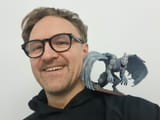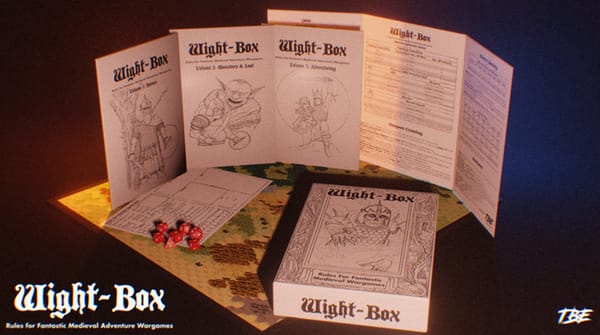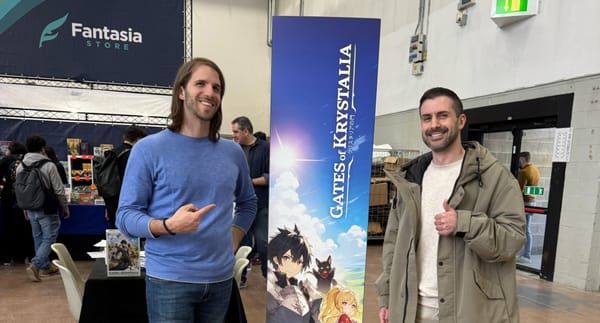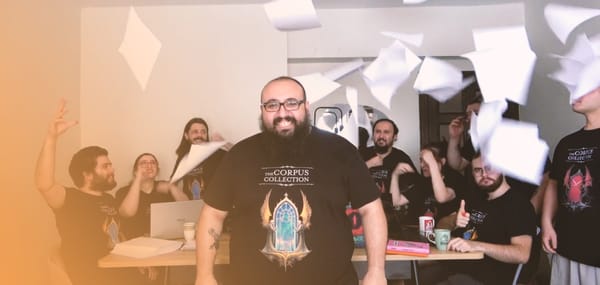From Scans to Sculpting: The Unlikely Origins of The Printing Goes Ever On

What drives someone to walk away from a career in medicine and instead dive headfirst into the niche, chaotic world of 3D-printed fantasy miniatures? For the founder of The Printing Goes Ever On, the answer is as honest as it is refreshing: freedom. The freedom to wake up without an alarm clock, the freedom to sculpt dragons instead of diagnosing patients, and above all, the freedom to build something on your own terms—without anyone standing over your shoulder telling you how to do it.
But this isn’t just a tale of rebellion against the 9-to-5. It’s a raw, behind-the-scenes look at what happens when a lifelong passion for digital design, forged in the modding communities of childhood and sharpened by real-world failures (hello, shady game dev contracts), collides with the rise of accessible 3D printing technology. What began with trying to squeeze quality minis out of an old Ender 3 eventually evolved into something far bigger: a full-blown Patreon powerhouse, complete with modular mini creators, a thriving Discord community, and cross-branded ventures that range from real-size props to customer-voted fantasy figures.
In this post, you'll hear directly from the creator about the realities of the business—both the brilliant and the brutal. From Kickstarter lessons and IP philosophy to navigating an oversaturated market and building a team that can actually survive the monthly madness of miniature releases, it's all here. No fluff, no over-polished marketing speak—just practical insights, hard-earned advice, and a few great stories along the way (like using a medical-grade 3D scanner to make miniatures of convention-goers).
Whether you're an aspiring sculptor, a curious hobbyist, or someone simply interested in how passion projects become full-time careers, this is a story about what it really means to print your own path.
Onward!
What motivated you to establish The Printing Goes Ever On, and how did your journey in 3D miniature design begin?
My primary motivation was to establish my own business, so I wouldn’t have someone telling me what to do. I finished med school, so I had a perspective of at least another 10 years of being bossed around.
The other big motivation was to be able to get up at whatever time I wanted :)
My journey with 3D design started when I was about 12 and I was making some video game mods. I got hired by some shady game dev company and I made a bunch of models for them. Obviously, the project failed and I didn’t get paid.
Fast forward to the era of accessible 3D printers. I designed lots of FDM technical designs and tried to get an old Ender 3 to print out cool minis. We all know how it ended…
The turning point was a medical study I was conducting. I bought a 3D scanner (cause the Clinic didn’t have budget for fancy stuff like that), and to make up for the cost, I 3D scanned people and made them minis at conventions. Soon, it turned out it’s much more efficient to just sculpt the models.
After getting better, sculpting on commission and so on, I started my Patreon.
How do you approach the design process to ensure your miniatures resonate with classic fantasy themes?
In my art direction I aim for believability. And what better way to achieve it than to look at historical references. Then, some fantasy elements can be applied on top of the proper groundwork that’s based on reality. In the end, that’s also how classic fantasy emerged.
Can you elaborate on the development of the Modular Mini Customizer and the impact it has had on user engagement?
The need for the web app came from the frustrating process of picking bits for modular minis. It was our first fully modular set and I wanted to preview how the models would look with different parts applied. It was an annoying process, and I suspected it would also be like this for our Patrons.
I found a 3D framework that would load 3D meshes safely and efficiently in a browser, so I wouldn’t need to worry about different operating systems and compiling executables.
The customization, however, would not be complete without exporting of STLs. The key here is to get print ready files, so that the user can just drag&drop them into their slicer of choice. That’s why the app offers the option of export of pre-supported elements.
After lots of scripting and many revisions, we are currently at our 12th modular faction bundle.
Those are always very popular with our audience, both in the subscription model and in store
purchases. And no wonder, as the offer of lifetime unlimited exports is quite unique on the market of customizable 3D miniatures.
Reflecting on your Kickstarter campaigns, what key lessons have you learned about launching and managing successful crowdfunding projects?
I won’t say anything that hasn’t been said before. The pre-launch period is the most important one. Collect your audience.
I’d not recommend working with influencers, as it’s often a waste of money you could spend on making a better product.
Engage with Backers.
Pick good partners for fulfilment.
How do you utilize social media to build and maintain a community around your products?
We regularly post on our social media, be it updates about monthly releases or community showcases.
But the core of our community is currently on our Discord server, where we’ve gathered over 4500 members.
What are your thoughts on the current trends in 3D printing for tabletop gaming, and how do you see the industry evolving?
Currently, it seems the 3D printing for tabletop industry is at a decline. If you look at any of the top 20 Patreons, their numbers are at a constant downward slope, which is not matched by growing numbers on other platforms.
There is not enough new people starting their 3D printing hobby versus the number of people who get bored or who abandon the hobby alltogether. This is especially visible in the warmer months, when people go out and enjoy the sunlight more :)
Have you engaged in collaborations with other creators or companies in the tabletop gaming industry? If so, what have those experiences been like?
We’ve been regularly doing cross promotions with other creators, and the experiences have been positive. Even if there isn’t much monetary gain from this, it’s still a way to spread the word about us and about friendly creators out there, plus the bonus rewards for our Patrons, of course.
Intellectual Property Considerations:
How do you navigate intellectual property rights when designing miniatures inspired by existing fantasy works?
As I mentioned before, the art direction is focused on historical designs, with a fantasy addition of races or creatures. That is why we don’t take inspiration from existing fiction works, and design our miniatures from scratch.
What measures do you take to ensure the quality and printability of your 3D models?
Most of our team are full-time employees, who have been trained and battle tested across the years. Still, all the models are always reviewed by seniors who vouch for their quality.
The models are then pre-supported, which is another step that provides extra technical quality feedback.
Finally, successful test prints prove all the checks were worth it!
How does customer feedback influence your design process and product offerings?
This depends on the brand under the EverOn Games umbrella. The Printing Goes Ever On doesn’t involve customers in the design process usually, but if there is something extra we can provide based on feedback, we usually do. DnD is a Woman is our other brand, which is purely customer-focused, with a monthly model being voted for by the community and often co-designed through a survey.
Props&Beyond, our real-size prop and puzzle brand, is making lots of props suggested by customers.
Finally, our latest acquisition, Fleshcraft Studio. Fleshcraft is a very personal brand – it’s creator, Frekie, is connected to their community and often adjusts upcoming designs to fit the needs of the customers.
What significant challenges have you encountered in running The Printing Goes Ever On, and how have you addressed them?
The constant challenge is to manage all the chaos. It’s a creative field, so a lot of the processes cannot be put in a rigid pipeline for easy project management.
Ensuring deadlines are met, quality is adequate, and everything is within budget – that’s a challenging game each month.
Our solution was hiring and training qualified employees, and creating customized solutions for the issues at hand.
Are there any upcoming projects or expansions that your community can look forward to?
EverOn Games is heading towards the physical space, with products landing on store shelves this year. We’re rapidly expanding the offer, including publishing of zines and books as well.
The most significant project for 2025 is our upcoming Kickstarter campaign, which will soon be available for preview.
What is your perspective on the use of artificial intelligence in the creation and customization of 3D models for tabletop gaming?
We’ve already seen a Kickstarter project with over 1000 bits and pieces for bases and dioramas, which was made with AI trained on a creator’s model collection. Of course, the models were not flawless, so they did have to fix each mesh in the end.
I think AI should be used as any other tool that improves our work, but not as a substitute of real craftsmanship.
How do you address sustainability and environmental considerations in your production and distribution processes?
We did not have to address those, due to being strictly digital.
In a competitive market, what strategies do you employ to differentiate your products from others?
Product quality speaks for itself. This, and quick customer service.
What steps have you taken to make your products accessible to newcomers in the tabletop gaming community?
All our models are 3D print-ready „out of the box”. Models designed for resin printing are pre-supported, so the user only needs to drop them into their slicer and slice. Models designed for FDM printing are supportless, i.e. they don’t need any supports to print.
Those considerations make it much easier for newcomers to start their 3D printing journey.
How do advancements in 3D printing technology influence your design choices and business strategies?
Recently, the biggest advancement was much more user-friendly FDM printing, including multi-material printing. We are aiming at catering to that new niche by expanding our Props&Beyond offer with multi-material products.
Can you discuss your approach to licensing your designs and collaborating with printing partners?
We’ve used the same approach as most other creators: as long as a printing partner is a subscribed commercial member, they have rights to sell prints of our models.
The only exception are one-off crowdfunding projects, which offer a lifetime license at a higher price.
We sometimes also do commission sculpting. This also involves a lifetlime license, at an extra cost of the service.
How do you balance creative ambitions with the practicalities of running a business?
You get used to it with time. What you might consider awesome yourself might not resonate with your audience. Sometimes, you can afford a little risk and make something more dashing than usual, but it’s a hit-and-miss.
Personally, I don’t consider myself an artist. I’m much more of a craftsman, doing my job well and providing value to people who enjoy the work. My ambitions are focused on an achieving and efficient workplace and thriving community.
What advice would you offer to individuals aspiring to enter the field of 3D miniature design for tabletop games?
My advice would be not to enter the field unless you have a substantial advantage or don’t have ambition to make it your full-time job. The niche is overflowing with small creators struggling to even reach the screens of potential customers.
If you want to work for some studio as a 3D designer, it’s also a tough world out there, full of competition and scammers.
Work hard on your portfolio, show off your most inspiring works and try to pave your way starting at collaborations with smaller studios to work your way up the ladder.





